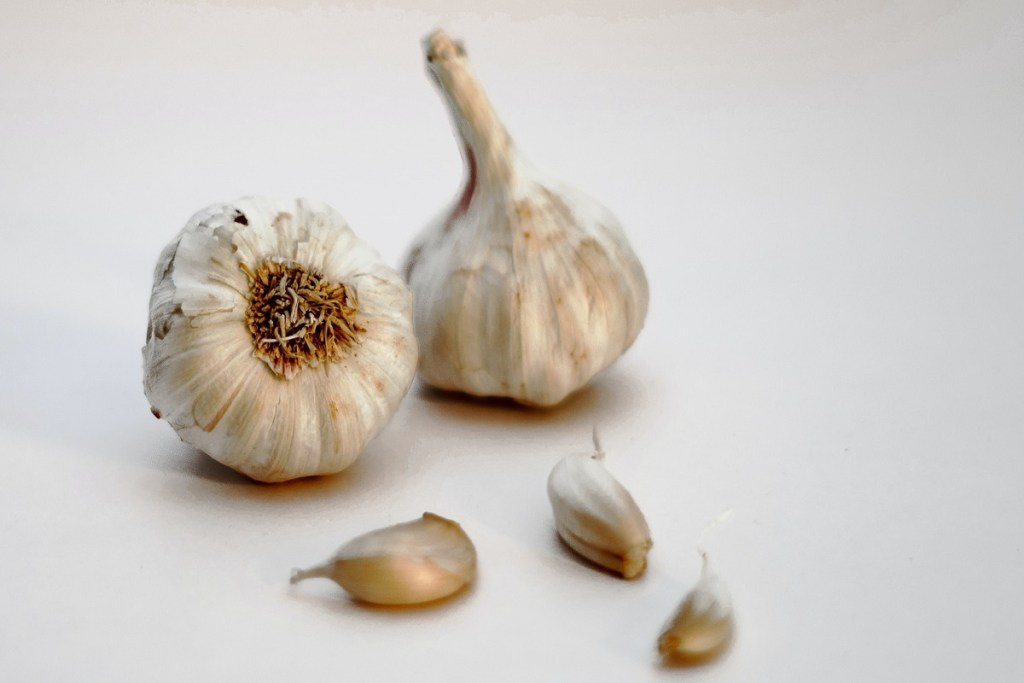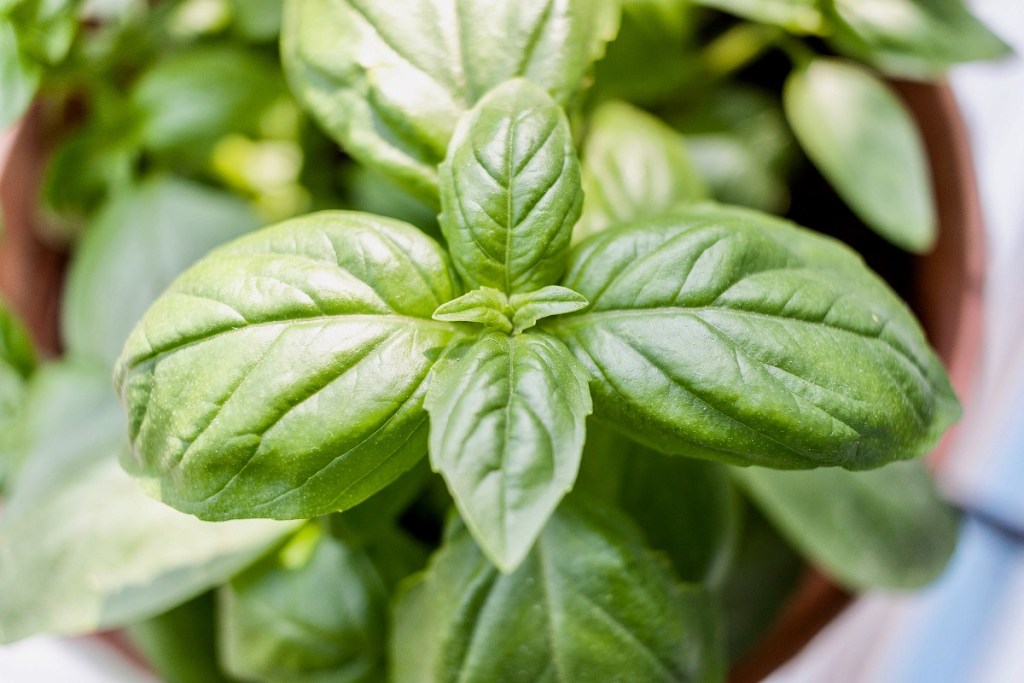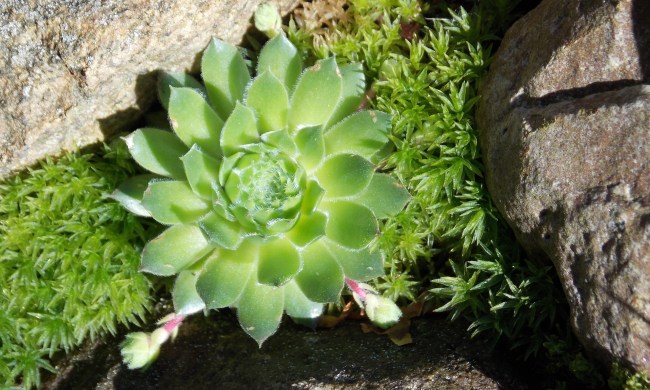One of the most stressful things at the beginning of every gardening season is the thought of pests plaguing your beautiful crops. What insecticide do you choose? How to prevent the infestation before it happens? Is the only solution to treat your crops with harmful chemicals? The answer, in fact, is no! Believe it or not, there are plenty of plants you can grow alongside your vegetables that will act as a repellent for certain pests. Whether it’s a natural garlic insecticide or basil plants interspersed around your tomatoes, there are preemptive steps you can take to help prevent insects from damaging your crops.

Garlic
Although botanically a vegetable, garlic is used more commonly as a spice or an herb. It can be grown in most conditions and doesn’t take up too much space in the garden, which makes it a great choice for a natural pest repellent. Mixing a few cloves in with your crops (or having a few different sections of garlic growing) will help keep away cabbage loopers, coding moths, fungus gnats, and spider mites.
Light needs
Even though it grows mostly underground, garlic actually prefers quite a bit of sunlight to thrive. They’re a plant that loves full sun, growing its healthiest and happiest when it has six to eight hours of sunlight a day. This makes it perfect for mixing into your garden as you wish without having to worry about whether or not there’s enough shade in the bed.
Water needs
Garlic loves moist (but not soggy) soil, so you should aim to give it roughly one inch of water per week. This will, of course, vary depending on the amount of rainfall and the amount of heat that happens during the growing season — but that’s true with most plants. The hotter the weather, the more water they need to survive. If it rains a lot, check in on them but don’t give more water until the soil isn’t moist anymore.
Other uses for garlic
Aside from keeping pests away from your garden, garlic is great for adding flavor to your favorite dish, trying new recipes, or turning into black garlic. The culinary uses are far and wide, and people will even dry out garlic to hang as a decoration in their kitchen. (And it’ll keep any roaming vampires away, which is always a plus, right?)
Chives
Chives are another great herb that can be easily dispersed throughout the garden bed to help prevent pests in different areas. They help repel aphids, carrot flies, and spider mites, and as their greens grow, you’ll be able to harvest them to enjoy at your leisure.
Light needs
Chives grow best in an area with full sun, though they can tolerate a partial shade environment. This is a great pest-repelling herb for garden beds that have a shadier side in the mornings or evenings since they’ll be able to grow in that space. Keep in mind that chives are a cool-weather herb, so they’ll do best during the spring and summer. Although they won’t fully die in extreme summer heat, they will likely go dormant and you may not see much growth.
Water needs
Once established in the garden, chives are a relatively drought-tolerant plant. They’ll enjoy regular watering, but if you forget to give them a drink for a few days in mild weather, it won’t be the end of the plant. The ideal environment for the best harvest is one where the soil is consistently moist but not soaked.
Other uses for chives
The most common use for chives is as an ingredient in dishes, especially salads. They grow lovely flowers, which are actually edible and can be eaten as well. If you choose to leave the flowers on the plant, though, be aware that it will go to seed and likely increase the amount of chives in your garden the following season.
Mint
Both spearmint and peppermint can help repel fleas, flies, and spiders (thank goodness!) from your garden. The downside of growing mint, though, is that it can be invasive. Gardeners will often grow mint in containers to keep it from spreading too much; however, it will do fine in a garden bed so long as you have the time to dedicate to maintenance.
Light needs
Mint plants enjoy locations with full sun to partial shade, and most varieties don’t tolerate cold well. Mint should be planted a little bit into the season and after the final threat of frost has passed. Peppermint is a variety that can survive a light frost; however, it’s always better to be safe than sorry when growing a crop and is best not to risk it in the cool beginnings of spring.
Water needs
To thrive and be happy, mint plants should be watered regularly and the soil should have time to dry out between waterings. You want to be cautious of overwatering these plants, as they hate being completely soaked, so getting a balance of moist soil can be difficult at first.
Other uses for mint
Mints make for beautiful garnishes to dishes and desserts. If you’re feeling particularly adventurous, you can use the harvested mint leaves to make homemade teas and share some with friends and family. Sprigs of mint also make great accents to live floral arrangements both for their look and their aroma.
Catnip
Catnip plants are great for helping keep away ants, aphids, cabbage loopers, Colorado potato beetles, cockroaches, flea beetles, Japanese beetles, squash bugs, and weevils. The downside to having catnip in your garden is that it may attract the local cat population. Catnip should be grown with caution if you don’t want cats waltzing through your tomatoes and would do best in a garden with a fence high enough to keep cats out.
Light needs
Catnip does best in full sun to partial shade, so it can be grown in almost any part of the garden you want it in. You can even choose to keep it isolated in containers around the edge of your garden bed to minimize the risk of kitty paws stepping on your cucumbers.
Water needs
Your catnip should be watered regularly while allowing the soil to mostly dry out between waterings. Water requirements should be kept in mind when deciding where to plant in the garden. Your catnip won’t do well next to plants that like consistently moist soil.
Other uses for catnip
The only other use for catnip would be if you have kitties and wanted to give them some fresh catnip to roll around in; however, keep in mind that although catnip is often given to cats, the ASPCA lists the plant as toxic due to the fact that it causes some cats to have diarrhea or vomiting.

Basil
Not only is basil beautifully scented, it’s also one of the best herbs you can plant alongside your tomatoes. Basil primarily helps prevent tomato hornworm infestations, which is a pest that not many other herbs help repel. Mixing in basil plants between your tomatoes should help with their longevity. The aroma also deters house flies and mosquitos.
Light needs
Basil plants need roughly six to eight hours of full sun each day to thrive. Proper sunlight, for any plant, lowers the risk of disease and helps the plant grow nice and sturdy. If you live in a particularly hot climate (think closer to the equator), then you’ll want to provide some shade for your basil plant to protect it.
Water needs
Basil should be watered regularly and thoroughly. Due to the amount of water it enjoys, you’ll want to make sure the area has well-draining soil. If you want to help keep the moisture in during warmer weather, you can always put down a layer of mulch.
Other uses for basil
Basil is a popular herb used for homemade pizza sauce, pasta sauce, and garnishes. You can lay fresh basil leaves on the dough as a topping or dry out the sprigs to put in a shaker for later use.
The fact there are herbs that can help keep pests away is really something amazing. And the plus side of all these herbs (except maybe the catnip) is that they’re multipurpose. Grow them for some added protection and for a little extra something to harvest from your garden.


